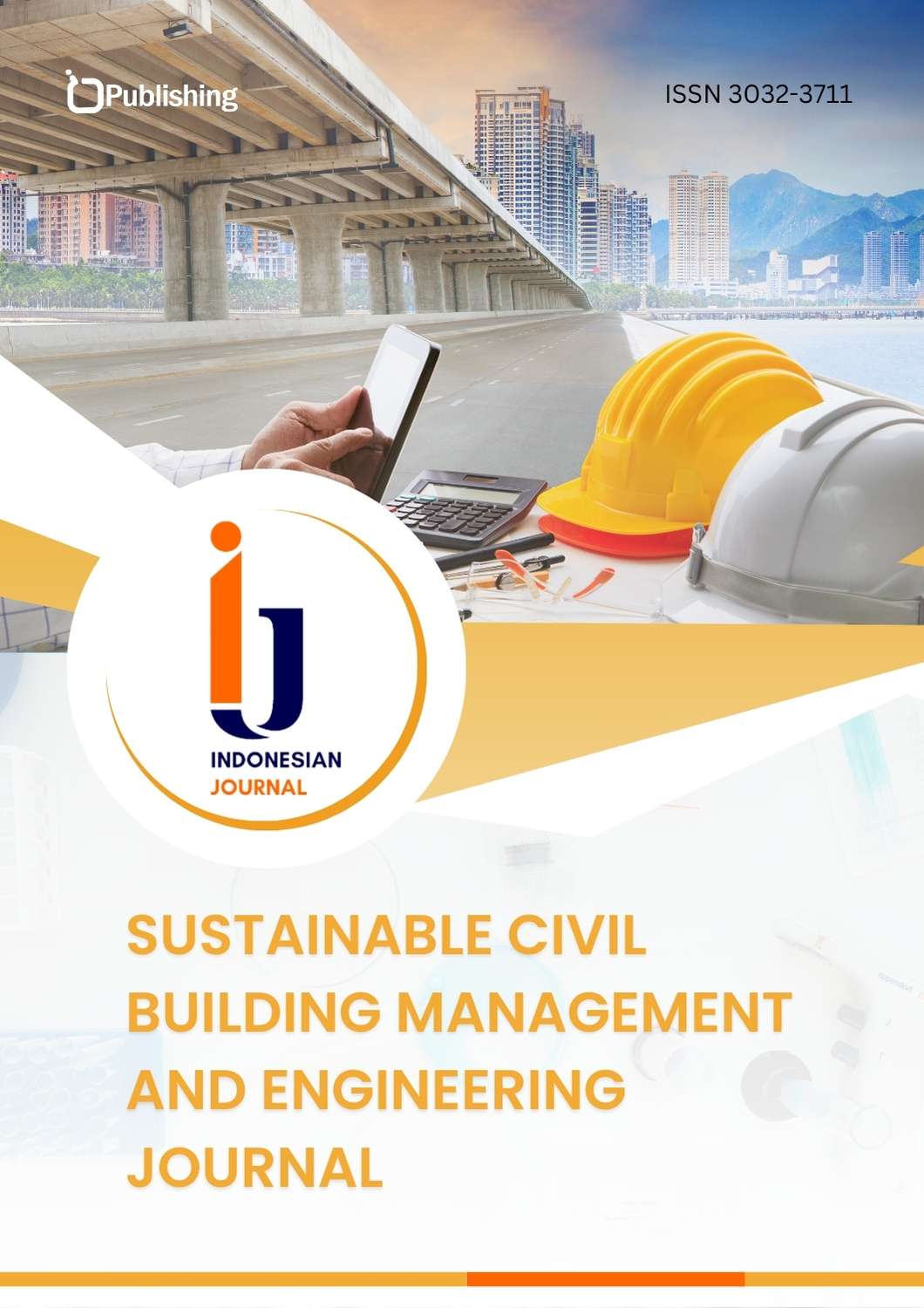Comparative Analysis of Volume and Cost of Box Culvert Using Quantity Take Off and Conventional Calculation Methods in Toll Road Project
DOI:
https://doi.org/10.47134/scbmej.v2i2.4397Keywords:
Building Information Modelling, Quantity Take Off, Autodesk Revit, Cost EstimationAbstract
Technological advancements in the construction industry have significantly transformed project planning and control practices, particularly through the integration of Building Information Modeling (BIM). This study aims to compare the efficiency of volume and cost estimation for box culvert structural work using the conventional method and the BIM-based Quantity Take-Off (QTO) approach. The research was conducted as a quantitative case study on the Serang–Panimbang Toll Road Project, Section III, Package 2. Modeling was performed using Autodesk Revit, and data analysis was supported by Microsoft Excel. The study found that the total volume of Class C-2 structural concrete (F’c 20 MPa) amounted to 541.986 m³, while reinforcement using deformed steel bars (BjTS 420B, fy’ 420 MPa) totaled 63,307.27 kg. Volume discrepancies between the two methods ranged from 2%–11% for concrete and 19%–28% for reinforcement. Cost analysis revealed savings of IDR 69,333,150.00 for concrete work (4.38% efficiency) and IDR 361,957,107.00 for reinforcement (22.65% efficiency) when using the BIM-based QTO method. These findings demonstrate that BIM-based QTO provides higher accuracy in representing geometric complexity, reduces estimation errors, and enhances both cost and material efficiency. The study also highlights the applicability of BIM beyond vertical construction, extending its relevance to horizontal infrastructure projects. Therefore, the BIM-based QTO approach is recommended as a reliable and effective tool for cost planning in large-scale infrastructure developments, particularly toll road construction.
References
Azhar, S. (2011). Building Information Modeling (BIM): Trends, Benefits, Risks, and Challenges for the AEC Industry. Leadership and Management in Engineering, 11(3), 241–252. https://doi.org/10.1061/(ASCE)LM.1943-5630.0000127
Basuki, T., & Handoko, Y. (2019). Evaluasi Efisiensi Perhitungan Volume Beton Box Culvert Menggunakan Perangkat Lunak Quantity Take Off. Jurnal Konstruksi, 8(3), 33–41. https://doi.org/10.31289/jkonstruksi.v8i3.3211
Direktorat Jenderal Bina Marga. (2020). Standar Perencanaan dan Pelaksanaan Struktur Jalan Tol. Kementerian PUPR.
Firdaus, A., Ramadhani, N., & Prasetya, A. (2023). Integrasi BIM dan QTO dalam percepatan estimasi proyek infrastruktur. Jurnal Teknik Sipil dan Lingkungan, 11(1), 25–34. https://doi.org/10.36787/jtsl.v11i1.2023
Ghaffarianhoseini, A., et al. (2017). Building Information Modelling (BIM) uptake: Clear benefits, understanding its implementation, risks and challenges. Renewable and Sustainable Energy Reviews, 75, 1046–1053. https://doi.org/10.1016/j.rser.2016.11.083
Hardin, B., & McCool, D. (2015). BIM and Construction Management: Proven Tools, Methods, and Workflows. John Wiley & Sons.
Kadir, A., Rachmat, B., & Gunawan, H. (2020). Implementasi Quantity Take Off dalam Estimasi Proyek Konstruksi Menggunakan BIM. Jurnal Teknik Sipil, 15(2), 89–98. https://doi.org/10.14710/jts.v15i2.23345
Kamil, I., Alias, B., Mohammed, A. H., Putri, N. T., & Kalani, C. (2013, June 23). Design of Performance Evaluation Tools for Drainage of Roads System in Developing Country (Case Study: Drainage System for City Roads in Padang Indonesia). https://doi.org/10.13033/ISAHP.Y2013.035
Kim, H., & Park, M. (2021). Development of BIM-based quantity takeoff system for highway projects. KSCE Journal of Civil Engineering, 25(2), 491–501. https://doi.org/10.1007/s12205-021-0891-4
Laorent, D., Nugraha, P., & Budiman, J. (2019). Analisa Quantity Take-Off Dengan Menggunakan Autodesk Revit. Dimensi Utama Teknik Sipil, 6(1), 1–8. https://doi.org/10.9744/duts.6.1.1-8
Lee, S., & Yu, J. (2020). Comparative analysis of BIM-based QTO and traditional quantity surveying in infrastructure projects. Automation in Construction, 118, 103293. https://doi.org/10.1016/j.autcon.2020.103293
Lu, W., Fung, A., Peng, Y., Liang, C., & Rowlinson, S. (2015). Cost reduction through Building Information Modeling-based quantity take-off systems. Journal of Construction Engineering and Management, 141(8), 04015035. https://doi.org/10.1061/(ASCE)CO.1943-7862.0000997
Monteiro, A., & Martins, J. P. (2013). A survey on modeling guidelines for quantity takeoff-oriented BIM-based design. Automation in Construction, 35, 238–253. https://doi.org/10.1016/j.autcon.2013.05.006
Moreno, N., Salazar, F., & Delgado, S. (2019). Comparative Analysis of Methodological Trends in the Management of Software Projects: Identification of the Main Variables. Tehnicki Vjesnik-Technical Gazette. https://doi.org/10.17559/TV-20170824233730
Nurdiansyah, R., & Huda, M. (2021). Analisis Perbandingan Estimasi Biaya Menggunakan Metode Manual dan Digital (QTO). Jurnal Rekayasa Sipil dan Desain, 9(1), 21–30. http://ejournal.unib.ac.id/index.php/jrsd/article/view/15677
Puspitasari, D., Syahrul, & Lestari, A. (2022). Analisis biaya dan waktu dalam pembangunan jalan tol: Studi kasus. Jurnal Riset Infrastruktur, 14(1), 22–30. https://doi.org/10.31294/jri.v14i1.2022
Putri, A., Harahap, R., & Hidayat, R. (2022). Studi Komparatif Estimasi Volume dan Biaya dengan Metode Manual dan Digital pada Proyek Gedung. Jurnal Rekayasa Sipil Indonesia, 14(1), 55–63. https://doi.org/10.26874/jrsi.v14i1.992
Rahim, A., & Latief, Y. (2021). Integrasi BIM dan QTO dalam perencanaan proyek infrastruktur. Journal of Sustainable Infrastructure, 10(1), 88–96. https://doi.org/10.9744/jsi.10.1.88-96
Sacks, R., Barak, R. (2010). Teaching Building Information Modeling as an Integral Part of Civil Engineering Curriculum. Journal of Professional Issues in Engineering Education and Practice, 136(4), 279–284. https://doi.org/10.1061/(ASCE)EI.1943-5541.0000025
Siregar, H., & Prasetya, F. (2021). Efektivitas Metode Quantity Take Off dalam Menghitung Volume Beton pada Proyek Infrastruktur. Jurnal Ilmiah Teknik Sipil, 11(1), 44–52. https://ejournal.undip.ac.id/index.php/jits/article/view/17745
Sukirman, S. (2010). Perencanaan Geometrik Jalan dan Pelengkapnya. Bandung: Nova.
Volk, R., Stengel, J., & Schultmann, F. (2014). Building Information Modeling (BIM) for existing buildings—Literature review and future needs. Automation in Construction, 38, 109–127. https://doi.org/10.1016/j.autcon.2013.10.023
Wijaya, R., & Sembiring, B. (2020). Perbandingan metode konvensional dan digital dalam estimasi volume pekerjaan jalan tol. Jurnal Sipil Digital, 3(2), 76–83. https://doi.org/10.21009/jsd.3.2.76
Zahran, R., Elshahat, A., & Marzouk, M. (2020). Automated QTO using BIM for infrastructure projects: A case study in Egypt. Journal of Construction Engineering and Management, 146(7), 05020008. https://doi.org/10.1061/(ASCE)CO.1943-7862.0001831
Downloads
Published
How to Cite
Issue
Section
License
Copyright (c) 2025 Muhammad Fajar Ramadhana; Agus Hari Wahyudi, Ary Setyawan

This work is licensed under a Creative Commons Attribution 4.0 International License.










